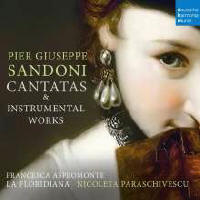Texte paru dans: / Appeared in: |
|
|
Outil de traduction |
|
|
Sandoni wrote at least three operas and nine oratorios, but the only music of his that survives is a handful of thoroughly competent secular chamber cantatas, string sonatas and harpsichord pieces. Nicoleta Paraschivescu and her group offer examples of each, sensitively mixing published works with others from manuscript collections. The early, dutifully Corellian trio sonata is nothing exceptional but Sandoni’s keyboard prowess (not to mention Paraschivescu’s) is apparent from a Ciaccona and an extensive and imaginative set of Folia variations. Both are Handelian in tone with perhaps an occasional hint of Scarlatti, while another tantalising historical niche for the composer is intimated by the fact that two of his smaller pieces are the same as works attributed to Bach (BWV836 and 837) in the Clavier-Büchlein für Wilhelm Friedemann Bach. Paraschivescu has no doubts that Sandoni is their author. The cantatas – unlikely to have been written for Cuzzoni – are typical of their kind, dealing prettily but not terribly deeply with aspects of love jilted, unspoken or blighted by doubt. Francesca Aspromonte’s singing is naturally radiant and musical, and shows an easy agility in Del timor d’un cor geloso, the most extrovert of the three. Although clarity is slightly undermined by a ringing church acoustic, this is a pleasing introduction to Sandoni. His colleagues may have disliked him, but we can perhaps forgive him.
|
|




